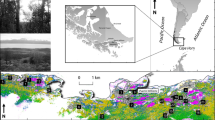Abstract
Habitat selection can be envisaged as a hierarchical spatial process, from choice of home range to choice of dietary item. The green woodpecker (Picus viridis) is described as being closely bound to cultivated land and deciduous forests, mainly due to its summer diet composed of ants (Hymenoptera: Formicidae) found on meadows and pastures. To explore possible responses of this woodpecker to recent changes in land use practice, we studied home ranges, feeding habitats and food selection of a marginal population (four radio-marked males and five females) in a 30,000-ha conifer-dominated landscape at the northern edge of its distribution range in south-central Scandinavia. We asked: (1) Is the green woodpecker confined to areas with cultivated land and deciduous forest? (2) If so, are important food items (ants) particularly abundant or exclusively found there? (3) Can clearcuts and young plantations substitute for cultivated land as feeding habitat? Home ranges (mean=100 ha) were invariably confined to the parts of the landscape that contained cultivated land (<1% of the total area). In summer, birds preferred to feed in cultivated land, presumably due to a higher overall biomass of ants compared to forest habitats. They avoided clearcuts, but preyed extensively upon soil-dwelling ants in young conifer stands (16–30 years old). We failed to find preferences for particular ant groups (Lasius niger and L. flavus) associated with cultivated land. The principal summer food was Serviformica, an ant group that was equally abundant in cultivated land and forest habitat. A positive correlation between ant body mass and a preference index suggests that the birds selected the larger ant species independent of habitat type. In winter, birds fed exclusively on mound-building Formica rufa-ants in closed-canopy, older forest stands. Our results indicate that the green woodpecker successfully utilizes young conifer plantations as feeding habitat. At a larger scale, we hypothesize that green woodpecker populations fail to establish in managed forest tracts, not because of food shortage, but because the landscapes lack cultivated land serving as a key stimulus encouraging individuals to settle.
Similar content being viewed by others
Author information
Authors and Affiliations
Additional information
Received: 16 February 1999 / Accepted: 20 December 1999
Rights and permissions
About this article
Cite this article
Rolstad, J., Løken, B. & Rolstad, E. Habitat selection as a hierarchical spatial process: the green woodpecker at the northern edge of its distribution range. Oecologia 124, 116–129 (2000). https://doi.org/10.1007/s004420050031
Issue Date:
DOI: https://doi.org/10.1007/s004420050031




